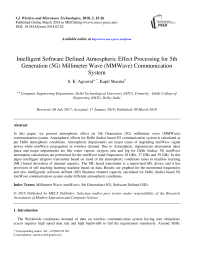Intelligent software defined atmospheric effect processing for 5th generation (5G) millimeter wave (MMWave) communication system
Автор: S. K. Agrawal, Kapil Sharma
Журнал: International Journal of Wireless and Microwave Technologies @ijwmt
Статья в выпуске: 2 Vol.8, 2018 года.
Бесплатный доступ
In this paper, we present atmospheric effect on 5th Generation (5G) millimeter wave (MMWave) communication system. Atmospheric effects for Delhi (India) based 5G communication system is calculated as per Delhi atmospheric conditions. Atmospheric impairments are major cause of degrading mmWave signal power while mmWave propagation in wireless channel. Due to Atmospheric impairments attenuation takes place and major impairments are like water vapour, oxygen, rain and fog for Delhi (India). 5G mmWave attenuation calculations are performed for the mmWave band frequencies 28 GHz, 37 GHz and 39 GHz. In this paper intelligent adaptive transmitter based on trend of the atmospheric conditions tunes to machine learning (ML) based derivation of channel capacity. The ML based transmitter is a supervised ML device and it has provision of self teaching learning machine based on data. Results are graphed for the mentioned frequencies and also intelligently software defined (SD) Shannon channel capacity calculated for Delhi (India) based 5G mmWave communication system under different atmospheric conditions.
Millimeter Wave (mmWave), 5th Generation (5G), Software Defined (SD).
Короткий адрес: https://sciup.org/15016921
IDR: 15016921 | DOI: 10.5815/ijwmt.2018.02.02
Список литературы Intelligent software defined atmospheric effect processing for 5th generation (5G) millimeter wave (MMWave) communication system
- Ghosh, Amitabha. "Can mmwave wireless technology meet the future capacity crunch?." Presentation at IEEE ICC (2013).
- Bergren, Steven. "Design Considerations for a 5G Network Architecture." arXiv preprint arXiv:1705.02902 (2017).
- Agrawal, S. K., and Kapil Sharma. "5G millimeter wave (mmWave) communications." Computing for Sustainable Global Development (INDIACom), 2016 3rd International Conference on. IEEE, 2016.
- Sun, Shu, et al. "Investigation of prediction accuracy, sensitivity, and parameter stability of large-scale propagation path loss models for 5G wireless communications." IEEE Transactions on Vehicular Technology 65.5 (2016): 2843-2860.
- Agrawal, S. K., and Kapil Sharma. "5G Millimeter Wave (mmWave) Communication System with Software Defined Radio (SDR)." International Conference on Recent Trends in Engineering & Science (ICRTES-16), 29th-30th September. 2016.
- Zhouye Pi et al., “An Introduction to Millimeter- Wave Mobile Broadband Systems, ” IEEE Communications Magazine, vol.49, no.6, pp.101- 107, Jun. 2011.
- Andrews J.G. et al., “What Will 5G Be?, ” IEEE JSAC Special Issue On 5G Wireless Communication Systems, May 2014.
- Yang L-L, Hanzo L. Software-defined-radio-assisted adaptive broadband frequency hopping multicarrier DSCDMA. IEEE Commun Mag 2002;40(3):174–83.
- Scudder, II. J., Adaptive communication receivers. IEEE Trans. Inform. Theory, 1965, 2, 167-174
- X. Wang, X. Li, and V. C. M. Leung, “Artificial Intelligence-Based Techniques for Emerging Heterogeneous Network: State of the Arts, Opportunities, and Challenges,” IEEE Access, vol. 3, 2015, pp. 1379–91.
- G. Huang, G.-B. Huang, S. Song, and K. You, ``Trends in extreme learning machines: A review,'' Neural Netw., vol. 61, pp. 32_48, Jan. 2015.
- Theodore S. Rappaport et al., “Millimeter Wave Mobile Communications for 5G Cellular: It Will Work!, ” IEEE Access, vol.1, pp.335-349, May 2013.
- FCC, “Millimeter wave Propagation: Spectrum management Implications,” office of Eng. and Tech., Bulletin no. 70, July, 1997.
- FCC “Report And Order And Further Notice Of Proposed Rulemaking” , FCC 16-89, July, 2016
- Evaluating Compliance with FCC Guidelines for Human Exposure to Radiofrequency Electromagnetic Fields, Federal Communication Commission, OET Bulletin 65, Edition 97-01.
- ITU Recommendation ITU-R RPN.618-4, 1996
- International Telecommunication Union, “Water Vapour: Surface Density and Total Columnar Content,” Recommendation ITU-R P.836-3, Electronic Publication, Geneva, Switzerland, November 2001.
- Recommendation, “Attenuation by atmospheric gases,” in ITU-R P.676-8, 10 2009.
- S. K. Agrawal and P. Garg, “Calculation of Channel Capacity Considering the Effect of Different Seasons for Higher Altitude Platform System", Wireless Personal Communications, Springer, Wireless Personal Communications: vol. pp-719-729, Issue 4 2010.
- S. K. Agrawal and P. Garg, “Calculation of the Channel Capacity in the Presence of Vegetation and Urban-site Environment for Higher Altitude Platform Communication System", to Wireless Personal Communications”, IET Microwaves, Antenna & Propagation, IET Microw. Antennas Propag., Vol. 3, Iss. 4, pp. 703–713, 2009.
- Agrawal, S. K., and Kapil Sharma. " Software Defined Radio Based Channel Capacity In 5G Millimeter Wave Communication System" International Virtual Conference on Computer Science, Engineering and Technology (25th - 28th December, 2016), Indore - India.
- S. K. Agrawal and K. Sharma, “5G Millimeter Wave (mmWave) Communication System with Software Defined Radio (SDR)”, International Journal for Innovative Research in Science & Technology, Volume 2, Issue 9, September 2016
- Dissanayake, A., Allnutt, J., & Haidara, F. (1997). A prediction model that combines rain attenuation and other propagation impairments along earth-satellite paths. In Proceedings of IEEE Transactions on Antenna and Propagation (Vol. 45, pp. 1546–1558), Oct. 1997.
- Blum, Avrim L., and Pat Langley. "Selection of relevant features and examples in machine learning." Artificial intelligence 97.1-2 (1997): 245-271.
- Kotsiantis, Sotiris B., I. Zaharakis, and P. Pintelas. "Supervised machine learning: A review of classification techniques." Emerging artificial intelligence applications in computer engineering 160 (2007): 3-24.
- J. Mitola. III, “Technical Challenges in the Globalization of Software Radio,’’ IEEE Commun. Mag., Feb. 1999, pp. 84–89.


